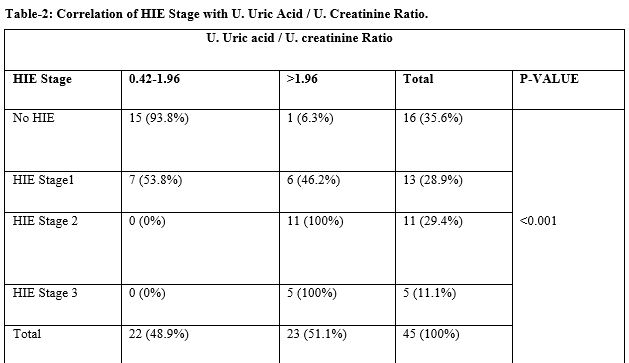The value of urinary uric acid and creatinine ratio in neonatal asphyxia
Abstract
Objective: The value of urinary uric acid and creatinine ratio in neonatal asphyxia.
Method: This was a prospective observational study conducted over one year, on 45 newborns admitted in NICU with perinatal asphyxia. Cord blood from the umbilical artery was sent for pH analysis and urinary uric acid and creatinine levels were estimated in spot urine samples.
Results: The urinary uric acid and creatinine ratio had a positive correlation with low APGAR scores at the 1st and 5th minute. Also, urinary uric acid to creatinine ratios was significantly higher in infants with severe HIE (3.180.61) when compared with infants of moderate HIE (2.190.32). It showed a significant negative correlation with pH of cord blood in neonates with perinatal asphyxia.
Conclusion: The urinary uric acid and creatinine ratio can be used as a supportive diagnostic test for early diagnosis of perinatal asphyxia.
Downloads
References
Costello A, Francis V, Byrne A, Puddephatt C. State of the World's Newborns: A Report from Saving Newborn Lives.2001;12(5):1-4
National Neonatal and Perinatal Database Report 2002-2003.1-58. Available at https://www.newbornwhocc.org/pdf/nnpd_report_2002-03.PDF.
Manzke H, Dörner K, Grünitz J. Urinary hypoxanthine, xanthine and uric acid excretion in new-born infants with perinatal complications. Acta Paediatric. 1977;66(6):713-717. doi: 10.1111/j.1651-2227.1977.tb07977.x.
Bhongir AV, Yakama AVV, Saha S, Radia SB, Pabbati J. The Urinary Uric Acid/Creatinine Ratio is An Adjuvant Marker for Perinatal Asphyxia. Europe J Pharmaceut Med Res. 2015;2(5):520-528.
Yashwanth K, Babu MS, Srinivas K, Mohan C, Aswani N, Rekha NA. A study of urinary uric acid to creatinine ratio in assessing the severity of birth asphyxia. IOSR J Dent Med Sci. 2017;16(10):69-76.
World Health Organization, working definitions neonatal and perinatal database South East Asia Regional; WHO, Geneva. 2006;1-7. Available at https://www.newbornwhocc.org/pdf/database.pdf.
Nelson KB, Ellenberg JH. American Academy of Pediatrics. The APGAR scores. Advances in Neonatal Care. 2006;6(4):220-223.
Krishnana E, Ponnusamy V, Sekar SP. Study of urinary uric acid and creatinine ratio as a marker of neonatal asphyxia for babies born in a tertiary care hospital. Int J Med Sci. 2017;5(12):5418-5423. doi: 10.18203/2320-6012.ijrms20175466.
Basu P, Som S, Choudhury N, Das H. Correlation between APGAR score and urinary uric acid to creatinine ratio in perinatal asphyxia. Indian J Clin Biochem. 2008;23(4):361-364. doi: 10.1007/s12291-008-0079-2.

Copyright (c) 2021 Author (s). Published by Siddharth Health Research and Social Welfare Society

This work is licensed under a Creative Commons Attribution 4.0 International License.


 OAI - Open Archives Initiative
OAI - Open Archives Initiative


